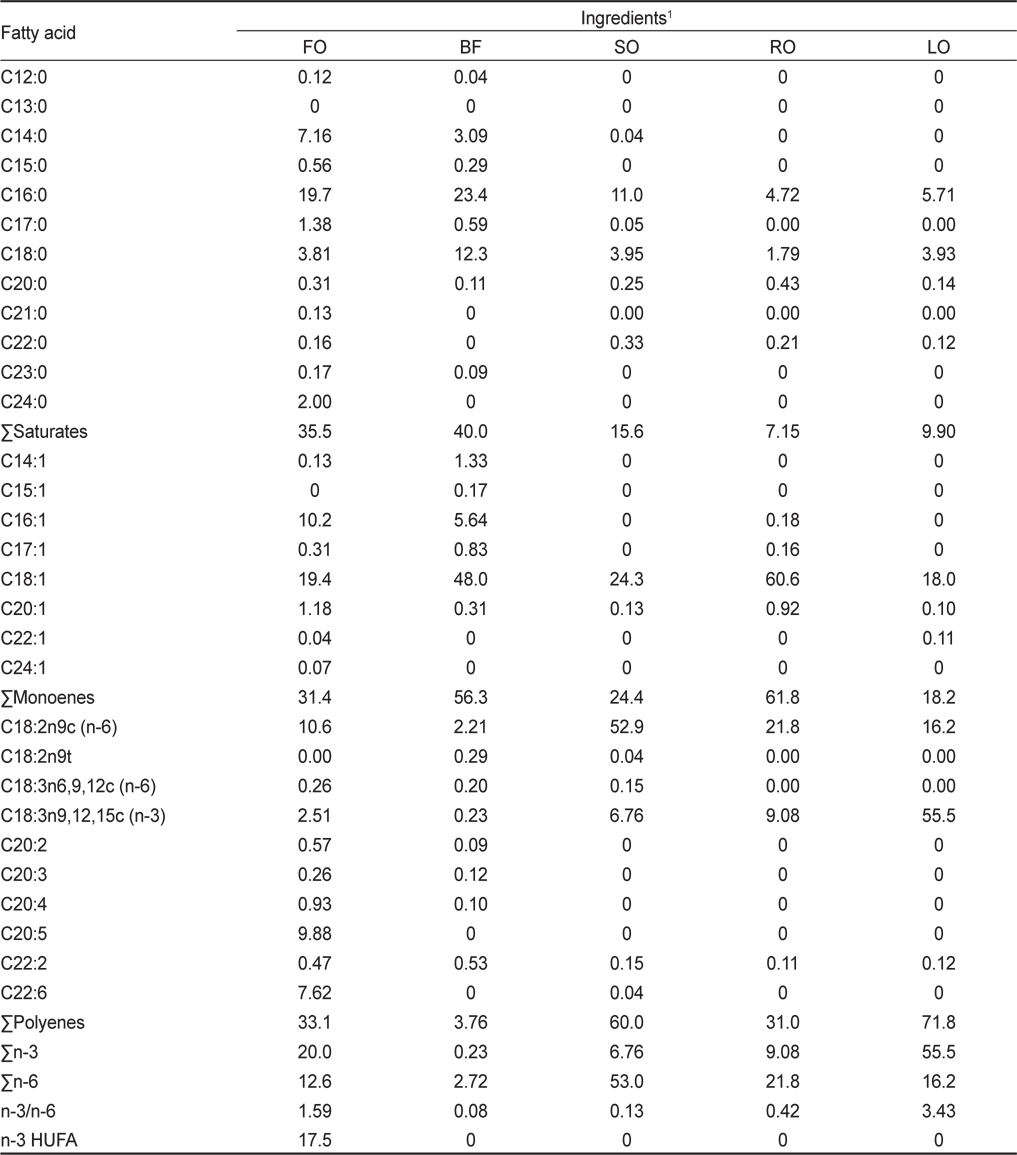



We conducted an 8-week feeding trial to evaluate dietary lipid sources on the growth performance and body composition of juvenile river puffer fish
전 세계적으로 양식업은 식품산업 중 가장 빠르게 성장한 분야 중 하나이며, 지난 10년 동안 수산식품의 수요를 충족시키기 위하여 연간 약 10%씩 생산량이 증가되었다(Özşahinoğlu et al., 2013). 전통적으로 양식업은 어획 부산물인 어분과 어유의 생산과 밀접한 관계를 갖고 있다. 양식용 사료의 원료로 어분과 어유가 차지하는 비중이 매우 높기 때문이다. 특히, 어류양식에 소요되는 비용 중 사료비용은 다른 요인들에 비하여 상대적으로 높은 비율을 차지하므로, 양식 경영에 최우선으로 고려되어야 할 요소이다(Choi et al., 2004). 양식 대상종에 적합한 배합사료를 개발하기 위해서는 대상어종의 성장에 필요한 영양소별 요구량을 규명하는 연구가 먼저 수행되어야 하며, 그 결과를 바탕으로 영양소 균형을 고려하면서 대상어종이 이용할 수 있는 원료의 선택과 이용성이 규명되어야 한다(Kim et al., 2010). 어류가 요구하는 필수영양소 중에 지질은 필수지방산과 에너지의 중요한 공급원이다. 사료에너지원으로써 지질은 단백질이나 탄수화물보타 에너지가가 높아 값비싼 사료 단백질을 절약할 수 있다(Choi et al., 2008; Mohseni et al., 2011). 어유는 다른 지질원료에 비하여 지방산조성 및 기호성 등이 우수하여 전통적으로 양어용 배합사료내 주요 지질원료로 사용되어 왔다(Eroldoğan et al., 2012). 그러나, 어유의 생산량은 전 세계적으로 지난 20여년간 약 100톤 규모로 더 이상의 증가를 보이지 못했으며, 오히려 1999년에는 약 80만톤 규모로 감소한 바 있다. 어유는 양식 산업의 발전과 함께 지속적으로 수요가 증가되고 있으나 공급이 따르지 못하여 가격 상승을 야기하고 있다. 또한 어유에는 환경호르몬인 다이옥신(dioxin)과 이와 유사한 폴리염화비페놀(PCBs) 물질을 함유하여 많은 문제점을 야기 할 수 있을 것으로도 우려되어, 산업적으로 양어사료 내 어유를 대체할 수 있는 지질원료에 관련한 연구가 절실히 필요하다(FSAI, 2002; Lundebye et al., 2004). 어유를 대체하기 위한 연구를 수행하기 위해서는 우선적으로 대상어류의 필수지방산을 규명 해야 하며, 해당 필수지방산의 적정요구량이 설정되어야 한다. Wang (2008)은 유어기 황복의 필수지방산은 DHA (docosahexaenoic acid, 22:6n-3)이며 적정 요구량은 0.5-1.0%라고 보고하였다. 또한, 황복과 같은 복어류에 속하는 자주복은 필수지방산으로 n-3계 고도불포화지방산(highly unsaturated fatty acid, HUFA)인 DHA와 EPA (eicosapentaenoc acid, 20:5n-3)를 0.5-1.5% 요구한다고 보고하였다(Han, 1996; Kikuchi et al., 2011). 일반적으로 양어용 배합사료를 제작할 때 지질원으로 n-3 HUFA가 다량 함유된 어유를 사용하며, 어유는 다른 동물성이나 식물성 기름보다 가격이 비싸므로 어분중에 함유된 지질을 고려하여 황복이 요구하는 DHA를 사료에 충족시켜 준다면 에너지원으로 어유 대신 우지, 대두유, 채종유 및 아마인유 등과 같이 값싼 지질원을 이용하여 배합사료 단가를 절감시킬 수 있을 것이다. 그러므로 본 실험은 치어기 황복을 대상으로 동·식물성 지질원인 우지, 대두유, 채종유 및 아마인유를 이용하여 어유 대체원으로써 이용 가능성을 확인하고자 수행되었다.
사육실험에 앞서 황복 치어를 유사한 크기로 선별하여 3,000 L 수조에 입식한 후 실험환경에 적응할 수 있도록 기초사료를 2주간 동일하게 공급하면서 예비사육을 하였다. 예비사육 후, 평균무게 10.3±0.03 g인 황복 치어를 40 L 사각수조에 각각 20마리씩 수용하여 각 실험구당 3반복으로 무작위로 배치하였다. 모래여과기에 의해 여과된 해수가 각 실험수조에 1 L/min씩 주입되도록 유수량을 조절하였으며, 각 수조 당 충분한 산소 공급을 위하여 에어스톤을 설치하였다. 실험기간 동안 평균수온은 27.4±1.5℃로 전 실험기간 동안에 자연수온에 의존하였다. 사육수의 염분은 26.7±1.46 psu이였고, 용존산소(DO)는 5.2-6.3 mg/L의 범위였다. 일일 사료공급량은 어체중의 4.3±0.05(%, DM)로 1일 2회(09:00, 16:00) 공급하였으며, 주 사육실험기간은 8주간 실시하였다.
실험사료의 조성은 Table 1과 같다. 단백질원으로는 갈색어분과 대두박을 사용하였고, 탄수화물원으로는 밀가루를 사용하였다. 지질원으로 어유(fish oil)를 대조구로 두고 우지(beef tallow), 대두유(soybean oil), 채종유(rapeseed oil) 및 아마인유(linseed oil)를 각각 단독 또는 n-3 HUFA (DHA+EPA)을 0.5%씩 첨가하여 9가지로 설계하였다(FO, BF, SO, LO, RO, BFH, SOH, LOH 및 ROH). 모든 실험사료는 원료를 혼합 후 펠렛제조기로 압출·성형하였으며, 표준체(sieve)로 고르게 친 후 밀봉하여 –20℃에 냉동 보관하면서 사용하였다.
[Table 1.] Composition of the experimental diets
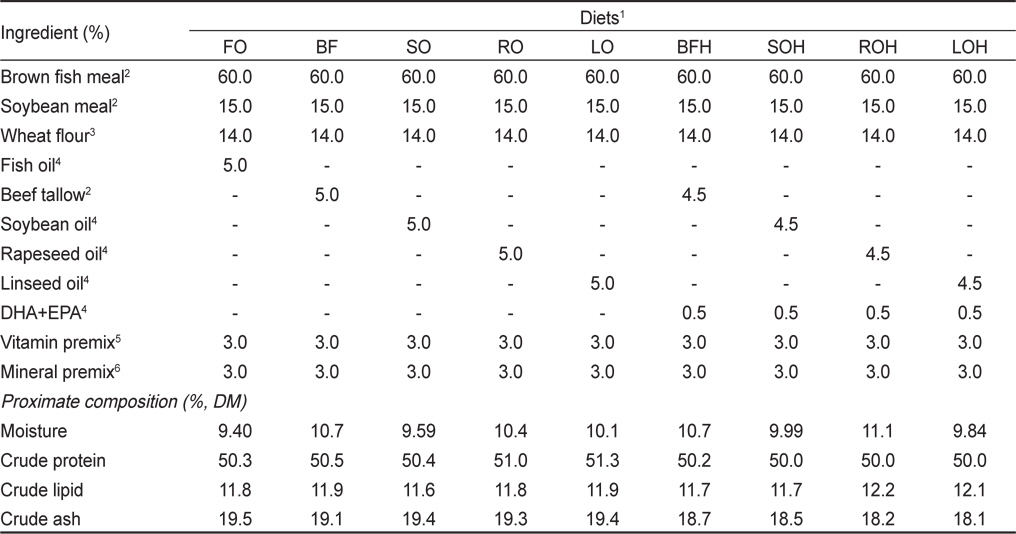
Composition of the experimental diets
어체 측정은 2주 간격으로 실시하였으며, 성장률을 측정하기 위하여 24시간 절식시킨 후 MS-222 (100 ppm)로 마취시켜 전체무게를 측정하였다. 실험종료 후, 증체율(percent weight gain, %), 일간성장률(specific growth rate, %/day), 단백질전환효율(protein efficiency ratio), 사료효율(feed efficiency, %), 비만도(condition factor), 간중량지수(hepatosomatic index), 내장중량지수(visceralsomatic index) 및 생존율(survival rate, %)을 조사하였다. 간중량지수 및 내장중량지수를 위해 각 수조별로 5마리씩 실험어를 포획하여 간 및 내장의 무게를 측정하였다.
실험사료와 각 수조별로 7마리씩 무작위로 추출하여 분쇄한 전어체를 성분분석에 이용하였다. 전어체 일반성분은 AOAC (Association of Official Analytical Chemists, 2000)방법에 따라 수분은 상압가열건조법(135℃, 2시간), 조단백질은 kjeldahl 질소정량법(N×6.25), 조회분은 회화로(Yj-8500D, Korea)를 이용하여 직접회화법으로 분석하였다. 조지질은 샘플을 12시간 동결 건조한 후, soxtec system 1046 (Tacator AB, Sweden)을 사용하여 soxhlet 추출법으로 분석하였다. 전어체 지방산 분석은 Folch et al. (1957)의 방법에 따라 클로로포름과 메탄올 혼합액(2:1)으로 총 지질을 추출하여 14% BF3-methanol (Sigma, USA) 용액으로 지방산을 methylation 시킨 후, capillary column (SPTM-2560, 100 m×0.25 mm I. d., film thickness 0.20 μm, USA)이 장착된 gas chromatography (HP-6890 PLUS, Hewlett-Packard, USA)로 지방산을 분석하였다. Carrier gas는 헬륨을 사용하였으며, Oven 온도는 최초 140℃에서 240℃까지 4℃/min 증가시켰다. 이때 injector 온도는 250℃, detector (FID) 온도는 260℃로 각각 설정하였으며, 표준 지방산으로 37개 지방산 혼합물(PUFA 37 Component FAME Mix, USA)을 사용하였다. 실험종료 후, 증체율 조사와 함께 혈액성분 분석을 위하여 실험어를 각 수조당 3마리씩 무작위로 추출한 후 일회용 주사기를 이용하여 실험어의 미부정맥에서 혈액을 채혈하여 micro-hematocrit방법에 의해 헤마토크리트(hematocrit, PCV)를 측정하였으며, 동시에 Drabkin’s 용액을 사용하여 cyan-methemoglobin 방법(Sigma Chemical, St. Louis MO, total hemoglobin procedure No. 525)으로 헤모글로빈(hemoglobin, Hb)을 측정하였다.
모든 자료의 통계처리는 Computer Program Statistix 3.1(Analytical Software, St. Paul MN. USA)로 분산분석(ANOVA test)을 실시하여 최소유의차검정(LSD : Least Significant Difference)으로 평균간의 유의성(
8주 동안 사육한 황복 치어의 성장결과는 Table 4에 나타내었다. 증체율과 사료효율은 FO 및 SOH 실험구가 BF 및 RO 실험구에 비하여 유의한 차이로 높게 나타났으며(
[Table 2.] Fatty acid composition of lipid sources (% of total fatty acids)

Fatty acid composition of lipid sources (% of total fatty acids)
[Table 3.] Fatty acid composition of the experimental diets (% of total fatty acids)
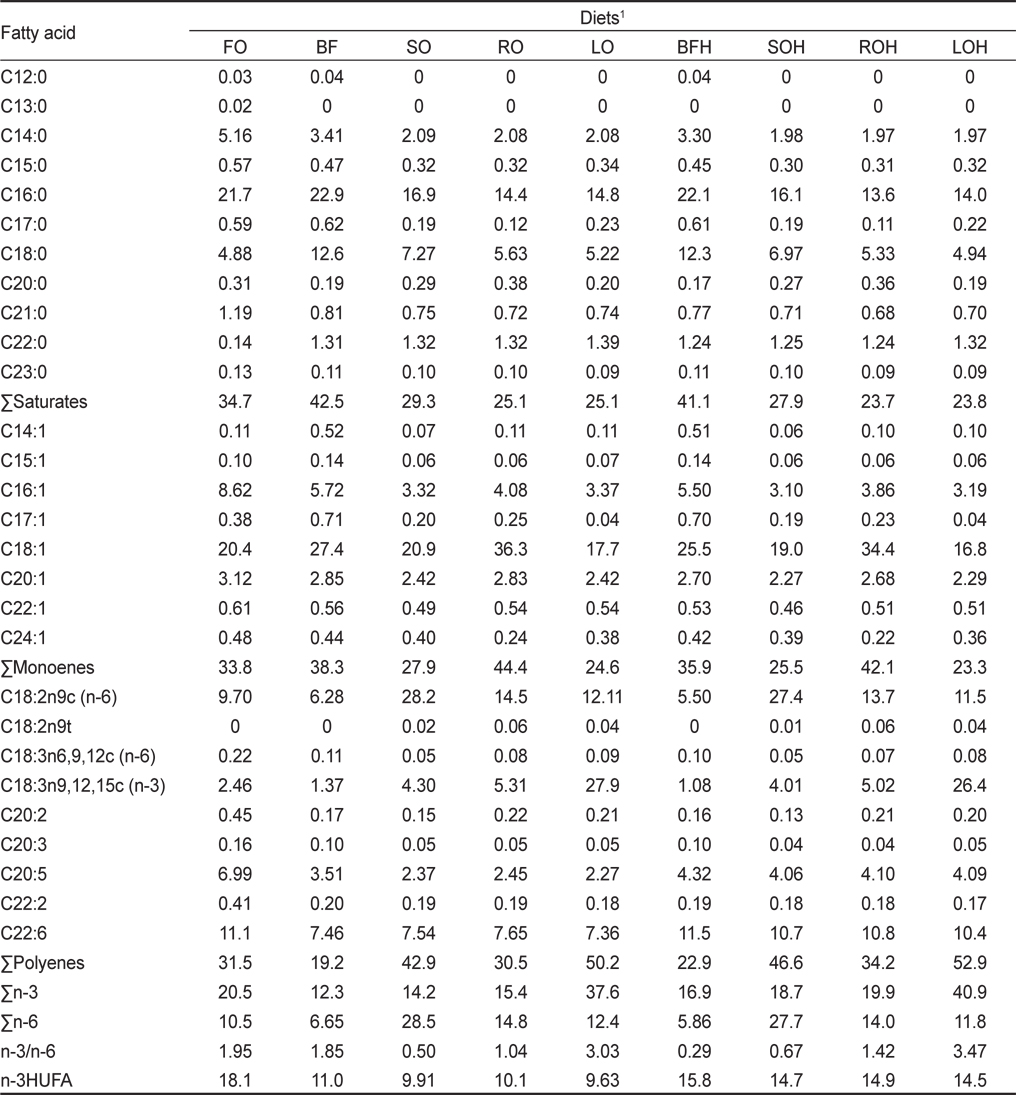
Fatty acid composition of the experimental diets (% of total fatty acids)
[Table 4.] Growth performance of juvenile river puffer Takifugu obscurus fed nine diets for 8 weeks1
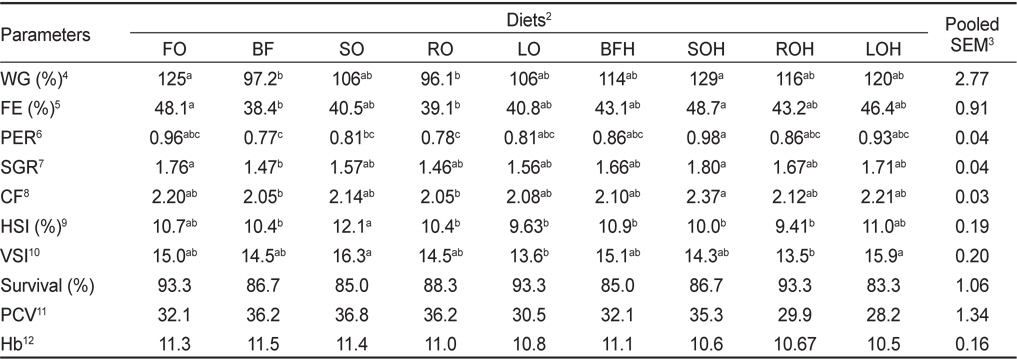
Growth performance of juvenile river puffer Takifugu obscurus fed nine diets for 8 weeks1
전어체 일반성분 조성의 변화는 Table 5에 나타내었다. 전어체 단백질 함량은 ROH 실험구가 BF 및 SO 실험구에 비하여 유의한 차이로 높게 나타났으며(

Whole body composition (%, DM) of juvenile river puffer Takifugu obscurus fed nine diets for 8 weeks1
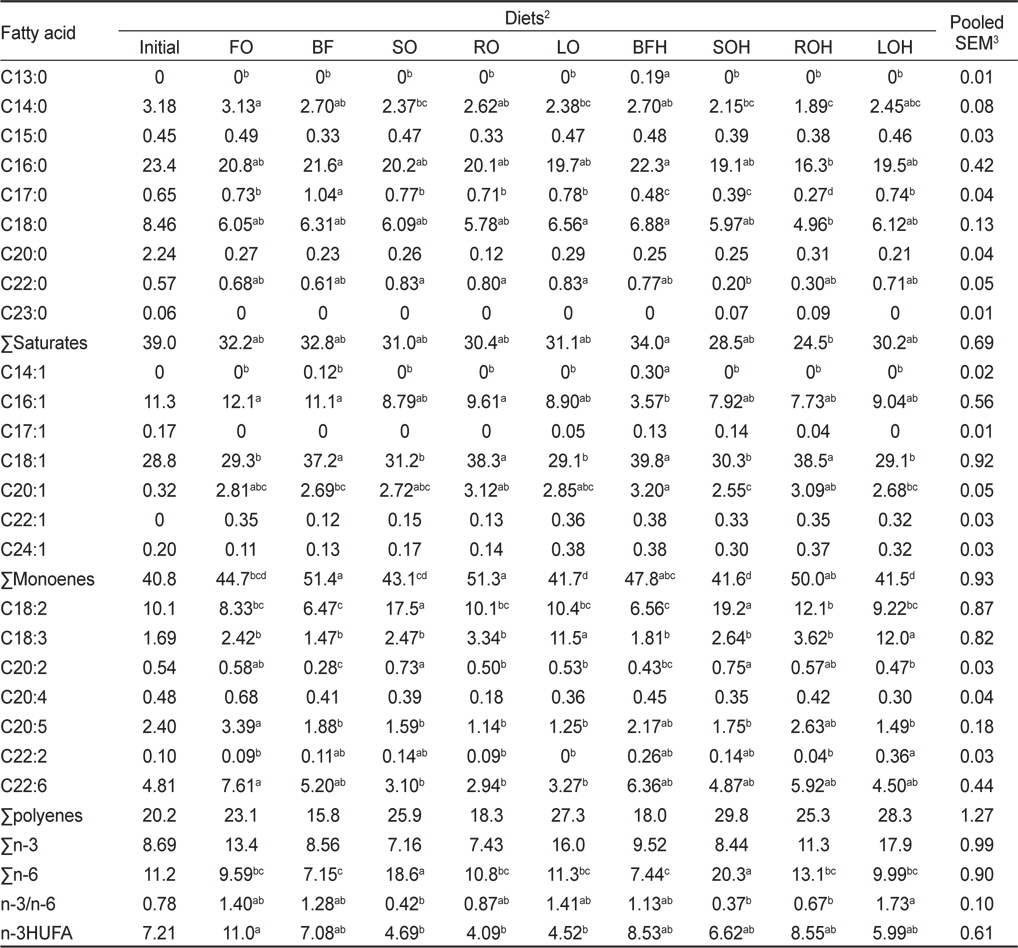
Whole body proximate fatty acid composition (% of total fatty acids) of juvenile river puffer Takifugu obscurus fed nine diets for 8 weeks1
어류는 체내 세포의 기능유지를 위해 필연적으로 특정한 지방산을 요구하는데, 이러한 지방산은 체내에서 자체적으로 합성될 수 없어 외부로부터 공급해 주지 않으면 정상적인 성장과 생존을 할 수 없다(NRC, 2011). 이와 같이 어류의 정상적인 성장과 생존을 위해 사료내 필수적으로 공급해 주어야 하는 지방산을 필수지방산이라 하는데, 어종 및 서식환경에 따라 필수지방산의 종류 및 양이 다른 것으로 알려져 있다. 일반적으로 담수어류는 사료 내 linoleic acid (18:2n-6)와 linolenic acid (18:3n-3)를 단독 또는 두 가지 모두를 필요로 하는 반면, 광염성 해산어류는 사료내에 EPA (eicosapentaenoic acid, 20:5n-3) 또는 DHA (docosahexaenoc acid, 22:6n-3)과 같은 n-3계 고도불포화지방산(n-3 highly unsaturated fatty acids, n-3 HUFA)을 필요로 한다(Webster and Lovell, 1990; Ruyter et al., 2000; Lee et al., 2003; Fonseca-Madrigal et al., 2005; Kim and Lee, 2005; Mourente et al., 2005). 본 연구는 치어기 황복을 대상으로 배합사료내 지질함량 중 40%를 어유(어분지질 60%, 실험 지질원 40%)를 이용하여 대조사료를 제작 후, 우지, 대두유, 채종유 및 아마인유를 단독 또는 각각 0.5%의 n-3 HUFA (DHA+EPA)를 첨가하여 어유 대체 가능성을 평가하였다. 실험사료에는 복어류의 필수지방산인 DHA와 EPA의 함량이 1.12-2.1%로 요구량 이상으로 함유 되었다. 성장 실험결과 대두유와 아마인유는 사료내 n-3 HUFA가 요구량 이상으로 함유되어 있을 경우 n-3 HUFA를 별도로 첨가하지 않아도 40%까지는 어유를 대체할 수 있었으며, 우지와 채종유는 n-3 HUFA를 0.5% 이상 첨가 하여야 할 것으로 판단된다. 반면, 우지, 대두유, 채종유 및 아마인유에 n-3 HUFA를 0.5%씩 첨가할 경우에는 어유를 40%까지 대체 할 수 있었다. 어유 대체와 관련한 다른 연구결과들을 확인하면, 자주복에서 단백질원 중 45%를 어분으로 하여 대구간유와 오징어간유 혼합유를 대조구(총 지질 10% 중 어분지질 3%, 혼합유 7%)로 두고 대두유와 아마인유를 단독 또는 n-3 HUFA를 2.6%씩 첨가하여 실험한 결과, 대두유와 아마인유를 단독 첨가할 경우 대조구에 비하여 성장이 유의한 차이로 감소되나, n-3 HUFA를 2.6%씩 첨가할 경우 대두유와 아마인유로 57%까지 어유를 대체할 수 있다고 보고하였다(KiKuchi et al., 2011). 또한, 사료내 어분 함량이 46% 수준일 경우 sharpsnout seabream에 있어 어유를 대두유 및 아마인유로 100% 대체할 수 있다고 보고하였으며(Piedecausa et al., 2007), 터봇에 있어서는 사료내 어분 함량이 50% 수준일 경우 대두유와 아마인유를 3개월 공급하고 다시 어유로 전환하여 공급하였을 경우 성장에 있어 유의한 차이가 나타나지 않았다(Rogost et al., 2003). 또한, murray cod 및 red seabream에 있어서는 사료내 어분 함량이 각각 10% 및 50% 수준일 경우 어유를 식물성유인 아마인유 및 유채유로 각각 완벽하게 대체할 수 있었다(Francis et al., 2006; Huang et al., 2007). 하지만, sea bass에 있어서는 사료내 어분함량이 50% 수준인 경우에 우지, 가금유, 돈지, 대두유 및 옥수수유를 이용하여 어유를 50% 수준까지만 대체가 가능하다고 보고되었다(Xue et al., 2006). 그외 담수어종인 lagemouth bass에 있어서는 사료내 어분함량이 40% 수준인 경우 어유를 계유로 대체 가능하다고 보고하였다(Subhadra et al., 2006).
전어체 일반성분 조성의 변화에 있어서는 실험사료의 동·식물성 지질원의 종류에 따라서는 차이를 보이지 않았으나, 동·식물성 지질원에 n-3 HUFA의 첨가 여부에 따라서는 전어체 단백질 및 지질함량들이 차이를 보였다. 우지, 대두유, 채종유 및 아마인유에 n-3 HUFA를 0.5%씩 첨가할 경우, 첨가하지 않은 실험구에 비하여 전어체 단백질 함량은 증가하고, 지질함량은 감소하는 경향이 나타났다. 이러한 결과는 n-3 HUFA의 첨가가 단백질 및 지질의 이용률에 영향을 끼쳤기 때문으로 추측되며, 앞으로 이에 대한 추가 연구가 진행되어야 할 것으로 사료된다. Kim et al., (2010)은 어체의 극성지질과 중성지질에 존재하는 지방산 중에서 16:0 (palmitic acid)과 18:1n-9 (oleic acid, elaidic acid)는 주요한 에너지원일 뿐만 아니라 n-3 HUFA와 함께 세포막 인지질 중에 결합되어 있는 주요지방산으로 어체내 지방산 중 함량이 가장 높다고 보고하였는데, 본 연구에서도 전어체 지방산 중에서 16:0과 18:1n-9의 함량이 포화지방산과 불포화지방산 중에서 각각 가장 높게 나타났다. 뱀장어, 자주복, sea bream, channel catfish, Atlantic halibut 등 다양한 어종에 있어서 사료의 지방산 조성이 어체의 지방산 조성에 영향을 끼친다고 보고 된바 있다(Ibeas et al., 1996; Bae et al., 2004; Aksoy et al., 2009; Koizumi et al., 2009; Kikuchi et al., 2011). 본 연구에 있어서는 전어체 지방산의 조성에 있어 동물성 유지인 우지는 n-3 HUFA의 첨가 여부와 관계없이 어유 실험구와 유사한 경향을 나타내었다. 한편, 식물성 유지인 대두유, 채종유 및 아마인유를 단독 첨가한 실험구들의 n-6 HUFA 및 n-3 HUFA 함량은 어유 실험구에 비하여 유의한 차이로 낮게 나타났다. 그러나, 식물성 유지에 n-3 HUFA를 첨가할 경우 지방산의 종류별로 약간의 차이는 있지만 n-3계 및 n-6계 지방산의 조성 및 함량에 있어 어유 실험구와 유의한 차이가 나타나지 않았다.
따라서 본 실험 결과를 토대로 사료내 단백질원으로 60% 이상의 어분을 사용할 경우 실험어의 성장만을 염두에 둔다면 총 지질 중 40%를 우지와 채종유에 n-3 HUFA를 각각 0.5%씩 첨가하고, 대두유와 아마인유는 단독으로도 어유 대체원으로 100%까지 사용 가능 할 것으로 판단된다. 그러나, 실험어의 성장뿐만 아니라 어체내 지방산 조성까지 고려한다면, 우지, 대두유, 채종유 및 아마인유에 n-3 HUFA를 0.5% 첨가하는 것이 바람직할 것으로 사료된다.



